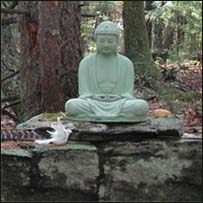|
|
 |

|

|

|
The greatest gift is the
gift of the teachings
|
|

|
| |
|
Dharma Talks
|
2015-09-22
On dukkha & dukkha nana
1:25:19
|
|
Patrick Kearney
|
|
|
We explore how the ordinary experience of dukkha becomes dukkha ñāṇa, understanding of the universal characteristic (samañña lakkhaṇa) of dukkha. We look at the how the perception of impermanence (anicca-saññā) creates anxiety when the heart intuits the groundless of experience, and how the unfolding of this anxiety is mapped by the dukkha ñāṇas of classical Theravāda Buddhism. Finally, we see how the experience of dukkha gives way to that of not-self (anattā), when the heart stabilises through the maturity of mindfulness (sati) and equanimity (upekkhā).
|
|
Blue Mountains Insight Meditation Centre
:
Month Long Retreat led by Patrick Kearney
|
|
|
2015-09-08
The fourth satipatthana
69:05
|
|
Patrick Kearney
|
|
|
Tonight we explore the fourth satipaṭṭhāna, that of tracking dharma or dharmas (dhammānupassanā). Tracking dharma (singular) involves learning the conceptual framework that gives meaning to the experiences we undergo. We learn to read our experience. When experience means something, then it can transform our life. Tracking the dharmas (plural) entails learning to perceive our experienced world as no more than a flow of phenomena, that arise and cease dependent on conditions. This represents the maturity of insight into not-self (anattā).
|
|
Blue Mountains Insight Meditation Centre
:
Month Long Retreat led by Patrick Kearney
|
|
|
2015-09-05
The “Thinning” of the Self: Exploring and Practicing Anattā (“Not-Self”) 1: Introduction and Overview
45:58
|
|
Donald Rothberg
|
|
|
The teaching of anattā (“not-self”) points to one of the three fundamental areas of liberating insight taught by the Buddha (along with the teachings on impermanence and on suffering or dukkha). Yet anattā can very challenging and confusing for contemporary practitioners. Is there “no self” (as anattā is sometimes translated)? How do we make sense of our feelings of individuality, identity, ancestry, and vocation? How do we address our own personal experiences of woundedness, trauma, and oppression? Are these all simply to be “transcended”? How is a sense of self actually in many ways important for contemporary spiritual development, and how is working with our own individual conditioning, whether psychological or social in origin, central to our liberation? How do we integrate attending to such conditioning with opening as well to the power and energy of experiences beyond the habitual sense of self?
In this daylong, we will explore these vital questions primarily in a practical way. Using the metaphors of “thinning the self” and working with a “thick” sense of self, we will cover three aspects of practice: (1) cultivating, in several ways, the “thinning” of the self, both in meditation and in everyday life, including working with the Five Skandhas or “aggregates” of experience; (2) tracking and working with different manifestations of a “thick” sense of self, both as appearing in experience and as hidden to awareness; and (3) opening to experiencing beyond a fixed sense of self, as awareness, compassion, and responsiveness deepen.
|
|
Spirit Rock Meditation Center
|
|
|
2015-07-30
Three Characteristics
45:07
|
|
Kim Allen
|
|
|
This is the fourth talk in a speaker series titled Fundamental Buddhist Principles 2015. As we observe our daily and meditative experience, the mind naturally begins to notice "universal" qualities of experience: impermanence (anicca), unsatisfactoriness (dhkkha), and emptiness (anatta). These three - especially impermanence - are gates to spiritual freedom. It's how we relate and react to these three characteristics that determine whether we suffer or be at peace.
|
|
Insight Meditation South Bay - Silicon Valley
|
|
In
collection:
Fundamental Buddhist Principles 2015
|
|
|
|
|